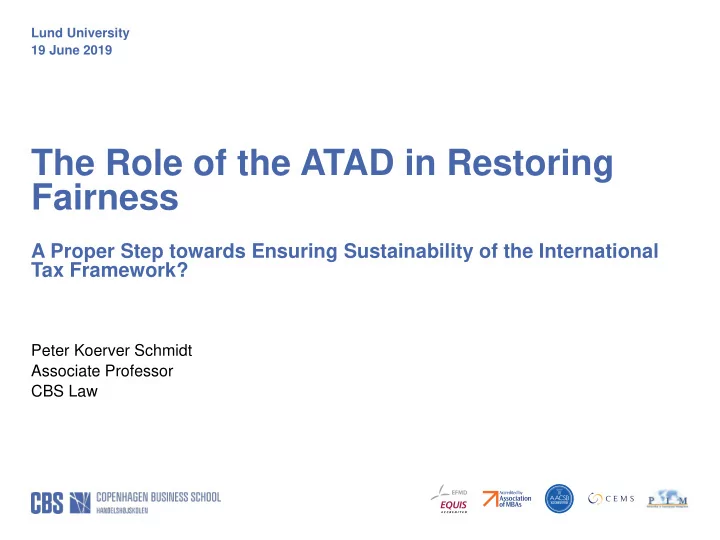

Lund University 19 June 2019 The Role of the ATAD in Restoring Fairness A Proper Step towards Ensuring Sustainability of the International Tax Framework? Peter Koerver Schmidt Associate Professor CBS Law
Research question Can the EU Anti-Tax Avoidance Directive (ATAD) be expected to promote tax fairness and thereby contribute to increased sustainability of the international tax regime? 2
Sustainability & fairness • Tax fairness (now) seems to be widely recognized as a precondition for sustainable international development • But what is (tax) fairness? • Economical approach • Philosophical approach • Political approach • Legal (juridical) approach, including the principles of: Legitimacy • Law is legitimate when socially accepted, i.e. when it receives its legitimacy from democratic procedures – Rule of law Equality • Persons in equal circumstances should be treated equally (taxation ability to pay) Certainty • The law should be clear, easily accessible, comprehensible, prospective and stable… 3
ATAD – Background • Anti- Tax Avoidance Package • A call for MS to take a stronger and more coordinated stance against companies that seek to avoid paying their fair share • ATAD • Adopted by MS in July 2016 • 5 legally binding minimum rules (4 SAARs and 1 GAAR) • To some degree a coordinated implementation of BEPS • The preamble: • It is imperative to restore trust in the fairness of tax systems… • The staff working document: • Fair burden sharing • Fair competition between businesses • The need to ensure sufficient revenues • Public perception • ATAD focuses on the EU/IM, BUT… 4
Legitimacy • MS has retained comptence in direct tax matters, but directives can be issued for approximation of legal measures that affect the IM • Principle of subsidiarity: The EU shall only act if the objectives cannot be sufficiently achieved by MS • Commission: The aims of tackling cross-border tax avoidance and to implement BEPS in a coordinated way ATAD is necessary • Principle of proportionality: The content/form shall not exceed what is necessary to achieve the objective • Commission: ATAD is a minimum directive Does not go too far • Critisism, e.g. the ATAD does not aim to reduce barriers within IM, but rather to ensure that MS can properly excersize their tax sovereignty • However, historical experience with tackling avoidance + various uncoordinated BEPS-measures by MS Legal basis probably OK 5
SAARs – Certainty & Equality • SAARs – Denies certain benefits under certain conditions (”sniper approach”), i.e. counter a specific type of abusive behaviour • ATAD SAARs: EBITDA, exit taxation, CFC taxation, hybrid mismatch rules • The SAARs are rather technical and complex Legal uncertainty • ATAD is a minimum directive No ”real” harmonization • But complexity probably even higher if no coordination at all • Risk of double taxation, but the EU has adopted the Directive on TDRM • The ATAD SAARs expected to promote tax equality • All MS will now have these SAARs Bolster the overall resilience of MS’ corporate tax systems MNEs ’ aggressive tax planning opportunites reduced MNEs taxed more in line with their ability to pay tax burden more fairly distributed between taxpayers and more level playing field for businesses 6
GAAR – Certainty & Equality • The scope of the GAAR and the exact relationsship with SAARs not particularly clear Legal uncertainty • But not a great suprise as uncertainty inherent in a GAAR • Perhaps ”legal certainty ” is the wrong test if the GAAR is workable for the compliant majority – UK experience (modest GAAR ” damage ”) • Court-developed anti-avoidance principles not necessarily more precise • The deterrent effect might reduce the need for courts to stretch staturory interpretation Reduce uncertainty of the overall tax system due to less litigation • The ATAD GAAR expected to promote tax equality • All MS will now have a GAAR Bolster the overall resilience of MS’ corporate tax systems MNEs ’ aggressive tax planning opportunites reduced MNEs taxed more in line with their ability to pay tax burden more fairly distributed between taxpayers and more level playing field for businesses 7
Conclusions • ATAD will have considerable impact on MS’ corporate tax systems • Too early to fully assess the merits of the ATAD • Based on a legal (juridical ) approach to fairness… • The ATAD does create legal uncertainty (in particular in the short run) • The use of both multiple SAARs and a GAAR could be questioned (risk of double taxation) • The ATAD is not a best solution and perhaps not even a second best solution, e.g. it does not provide full harmonization • However, the ATAD allegedly is a step forward • Some coordination better than no coordination • Expected to reduce aggressive tax planning opportunities for MNEs • MNEs will be taxed more in line with their ability to pay • Enhance equality among taxpayers and businesses • Improve public perception of the fairness of the international tax system and thereby contributing to sustainability 8
Recommend
More recommend